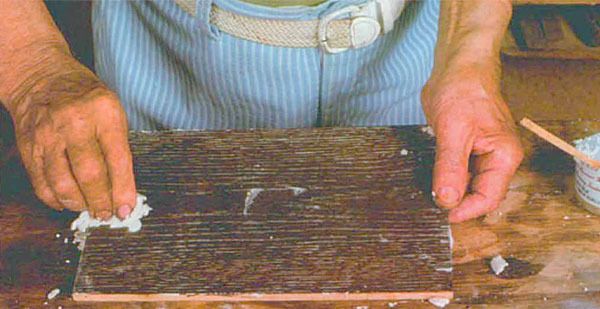Creating a Decorative Filled Finish
Treating wood's pores for color and contrast
Synopsis: George Frank learned a method of finishing in Hungary in the 1920s that involves dyeing the wood, sealing it and then packing the pores with contrasting filler. This technique adds color and brings out the grain pattern in any open-pore wood. He talks about how to prepare the wood with a scraper, sandpaper, and rainwater. He flushes out the sawdust with a blow gun and then scrubs the wood with a bristle brush. He explains how to color the wood, mix and apply the filler, and final finishing.
When I left my native Hungary and emigrated to Paris in 1924, I carried all my possessions in a small suitcase that couldn’t have weighed more than 15 lbs. But I also carried a wood-finishing method in my head that was to keep me busy experimenting for many years to come. The wood-finishing process involved filling the pores of dyed open-grain woods with a contrasting-color filler to produce decorative effects. My old wood-technology teacher at the Technological Institute of Budapest, Hungary, had showed me an example of decorative filling years earlier on an oak desk that had been blackened and its pores loaded with white filler. The effect was striking! Although he told me that the piece had been made by Central-European cabinetmakers around the turn of the century, he couldn’t tell me anything about the pore-filling process other than the composition of the white filler: plaster of Paris.
Three years later, I struck a bargain with the elderly owner of the rooming house where I lived: I repaired her furniture, and she gave me the key to a decent little workshop where I could experiment with decorative filled finishes. After endless research and hundreds of ruined samples-a potbellied stove helped me dispose of my errors and failures—I produced 15 pairs of master samples that helped my fledgling finishing business take a giant step forward.
Of all the finishing methods I’ve ever conjured up, the decorative filled finish is probably the most versatile and one of the most successful processes I’ve used to enhance wood furniture, cabinets, paneling and architectural interiors. A decorative filled finish is an easy, attractive way to dress up plain woods, giving them color and bringing out the grain pattern. It is accomplished by using a dye of one hue to color the surface of the wood, and a contrasting- or complementary-hue filler to color the pores. Thus, you can create a vast range of decorative effects, adding color as subtly or as boldly as you choose. I’ll tell you how I produce a set of samples with my decorative filled finish, including preparing the wood, dyeing or staining, sealing, filling the grain, and finishing. With these methods and a little practice, you can produce decorative filled finishes, like the samples on the facing page, and use them to create colorful effects on your furniture and cabinets.
From Fine Woodworking #83
For the full article, download the PDF below:


















Log in or create an account to post a comment.
Sign up Log in